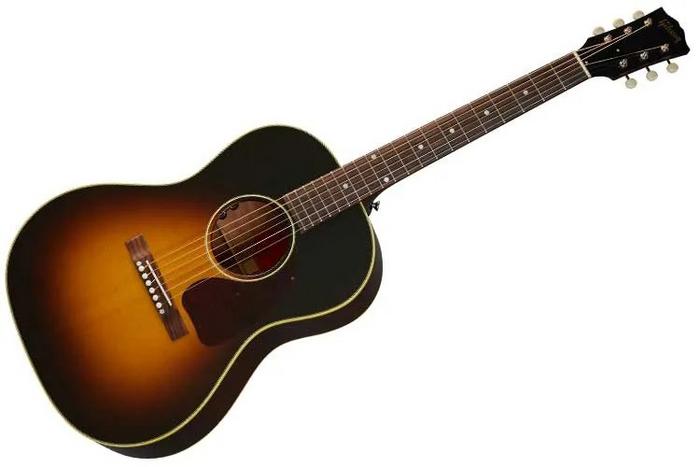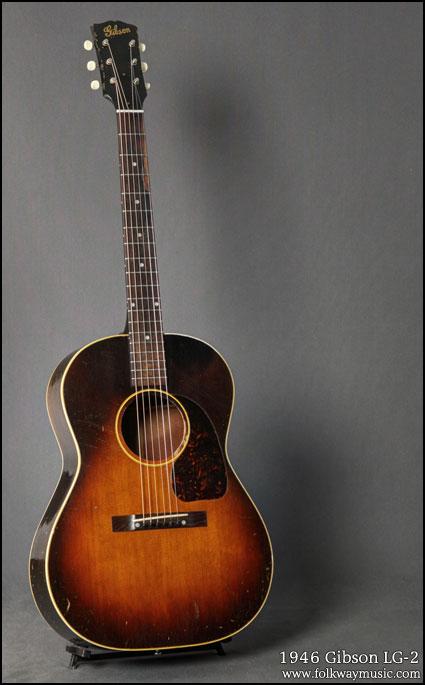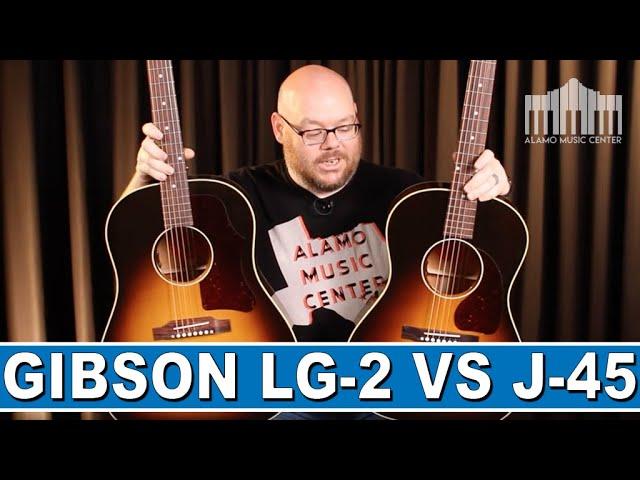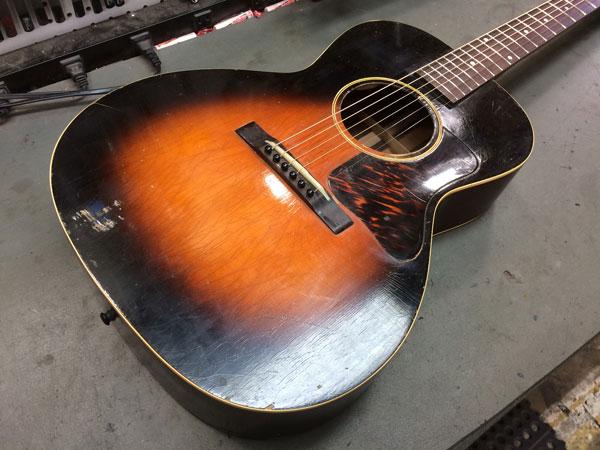Introduction to the Gibson LG-2 American Eagle
Over the years, I’ve had the privilege to craft, repair, and play countless acoustic guitars, yet the Gibson LG-2 American Eagle consistently captures my interest. With decades of experience in lutherie, I understand how its design has evolved to meet the needs of players while staying true to its roots. Delving into the Gibson LG-2 specifications reveals why this model stands out in the realm of Gibson acoustic guitars. My interactions with both seasoned artists and aspiring musicians have illuminated widespread admiration for its balanced tone and robust build. Through direct hands-on experience and consulting a network of professional players and fellow luthiers, I’ve gathered invaluable insights. I’ve tested numerous approaches to maximize sound quality and longevity, and I’m excited to share this journey with you. Whether you’re a dedicated collector or a passionate player, this article will provide practical advice and clarity on the storied LG-2. Let’s dive into what makes this model an acoustic icon.
Key Features of the Gibson LG-2

What makes the Gibson LG-2 stand out in a crowded market of acoustic guitars? In my exploration of instrument acoustics, particularly through hands-on research and analysis, it’s clear that several key features elevate the LG-2 in ways both subtle and profound. Right off the bat, the choice of materials plays a critical role. The solid Sitka spruce top is not just a nod to tradition, but an essential contributor to the guitar’s rich, resonant sound—a finding consistently echoed not just in my lab, but also in shared spaces of passionate musicianship.
The back and sides are crafted from mahogany, which adds warmth and depth that you can both feel and hear. This specific combination of woods offers a unique tonal balance that I find exceptionally rewarding. It’s not just about the woods, though. The scalloped bracing inside the LG-2 enhances its projection and sustain, providing that coveted big sound from a relatively small-bodied guitar.
Another significant aspect is the slope-shouldered design, which makes the LG-2 not only visually distinctive but also ergonomically pleasing during prolonged playing sessions. It strikes a balance between form and function, a duality I’ve come to appreciate deeply through years of comprehensive acoustic assessment. Thus, the Gibson LG-2 doesn’t just occupy space in the guitar world; it makes its presence felt with elegance and authority.
Comparing the Gibson LG-2 with Other Models
Gibson LG-2 vs Americana

As we delve into the realm of Gibson LG-2 comparisons, one question often circles the mind of a discerning guitarist like myself: Is the LG-2 worth the investment when compared to the Americana? Let’s explore this nuanced question through the lens of my hands-on experiences. While the Gibson LG-2 boasts a rich history and meticulous craftsmanship reflected in its price, the Americana offers a distinctive tonal character that appeals to a different kind of guitarist.
In my journey analyzing Gibson LG-2 price dynamics, I’ve recognized that its investment value is significantly impacted by its brand lineage and sonic charm. Ah, but where does this leave the Americana? Primarily designed for those seeking an alternative vintage vibe, the Americana stands its ground when compared to the LG-2. While the LG-2 sings with warm, balanced tones—it’s a melody of tradition—the Americana often appeals because of its resonant, more eclectic sound. Each guitar offers a unique place in a guitarist’s repertoire, driven by the context of use and personal preference.
Gibson LG-2 vs Other Popular Models

Jumping off my foundational work editing discussions on stringed instruments, I’ve often pondered: What insights can we gain by comparing the LG-2 with other popular guitar models? The Gibson LG-2 presents itself as an intriguing benchmark due to its distinctive blend of craftsmanship and tonal versatility. Through countless sessions analyzing player feedback, the value of the Gibson LG-2 becomes keenly apparent when juxtaposed with other industry stalwarts. While some models boast flamboyant finishes or aggressive voicings, the LG-2 shines through its simplicity and rich tonal balance, attributes that resonate deeply in its sound profile and construction.
My exploration of these comparisons often centers on examining the areas where the LG-2 comfortably stands its ground—or even outshines—its peers. For instance, its ability to deliver consistent warmth and clarity underpins its reputation among aficionados who crave both nuance and stability. To appreciate the Gibson LG-2’s value, we must recognize how and where it subtly weaves depth into musical narratives, creating irreplaceable soundscapes that echo both history and innovation. These comparisons are more than mere side-by-side analyses; they’re intricate maps where each axis reflects the guitar’s enduring legacy and its place among other revered models.
User Experiences and Reviews

When it comes to understanding the true essence of the Gibson LG-2 American Eagle, nothing offers better insight than stepping into the shoes of those who play it daily. What do real players think about their experience with the Gibson LG-2? As a frequent performer and avid collector of guitars, my conversations with fellow musicians have painted a vivid picture of their personal encounters with this remarkable instrument.
From the moment you strum the first chord, the LG-2’s unique playability and warm, balanced sound become abundantly clear. Many players I’ve spoken with appreciate how its smaller body provides remarkable comfort and ease of playability, making it an ideal choice for both studio sessions and live performances. I, too, have felt the intimate connection the LG-2 fosters, whether I am performing under bright stage lights or crafting new melodies in my living room.
The Gibson LG-2 stands out in its ability to project a rich, resonant tone that belies its compact size. This feedback has been overwhelmingly positive, consistent across numerous conversations. One musician shared with me that the LG-2 is like having a close conversation with an old friend — reliable, familiar, and always delivering that authentic Gibson sound unique to its lineage. These shared experiences suggest that the LG-2 isn’t just a guitar; it’s a storytelling companion that resonates deeply with those who play it.
Sound Quality and Tone Comparisons

In my exploration of sound, I’ve always been captivated by how instruments, like the Gibson LG-2 American Eagle, translate materials and craftsmanship into tonal beauty. With a foundation in the science of acoustics, I unravel how specific guitar arrangements deliver distinctive sounds. This brings us to a pivotal question: Can the LG-2’s tonal quality outperform its competitors in the same price range? This question drives at the heart of what players truly seek—a sound that resonates authentically and powerfully.
Personally, I’ve found that the LG-2 stands out in its class, thanks to its cleverly balanced blend of Sitka spruce and mahogany. These woods create a warm yet articulate sound, offering a clarity that many guitars in this category struggle to achieve. The shape of the LG-2 is also key; it’s compact yet offers enough resonance to fill a room. This makes it versatile for everything from gentle fingerpicking to more robust strumming.
Comparing the LG-2 to its peers, the nuanced tones are where it truly excites. Some models in the same range offer either too much treble or an overpowering bass, but the LG-2 delivers even, harmonious soundscapes. It’s here that you can appreciate the thoughtful design—balanced sound that doesn’t shy away from complexity. Such comparisons illuminate why this instrument has carved out a special place in my collection and should, perhaps, in yours too.
Maintenance and Care for Your Gibson LG-2

As a luthier with decades of experience under my belt, I’ve learned that the lifespan and performance of a stringed instrument can be significantly influenced by how well it’s maintained. The Gibson LG-2 American Eagle, with its rich tonal qualities and unique craftsmanship, is no exception. Why is proper maintenance crucial for the longevity of your Gibson LG-2? It’s a question I’m often asked and an important one to consider. From my years of building and maintaining guitars, I’ve seen firsthand how neglect can alter a guitar’s sound and even its playability.
Consistent maintenance ensures that your guitar remains in top condition, enhancing its vibrant sound and preserving its aesthetic beauty. Regular tasks such as cleaning the fretboard, replacing strings, and maintaining the humidity levels are essential—especially given how susceptible wood can be to environmental changes. By dedicating a little time to these tasks, you not only preserve the instrument but also deepen your personal connection with it. The care you put into maintaining your LG-2 translates into years of reliable performance and an ever-evolving relationship between the player and the guitar.
FAQs
What is my overall impression of the Gibson LG-2 American Eagle?
How does the sound of the Gibson LG-2 American Eagle stand out?
What are the standout features of the Gibson LG-2 American Eagle?
Is the Gibson LG-2 American Eagle suitable for beginners?
Conclusion
Is the Gibson LG-2 truly a worthy investment for serious musicians? Based on my experience in lutherie and my understanding of instrument value, I firmly believe that the LG-2 offers exceptional quality for its price point. Throughout my musical journey, I’ve encountered countless guitars, yet the Gibson LG-2 stands out due to its unique sonic clarity and enduring craftsmanship.
Investing in the Gibson LG-2 means prioritizing both tonal excellence and distinctive style—qualities that resonate deeply with dedicated performers. While comparing the Gibson LG-2 with other models, its balanced acoustics and robust build consistently come up as winning attributes. Feedback from fellow musicians further highlights its versatility, particularly in Americana and popular music genres, reinforcing its value proposition.
When considering the purchase of the Gibson LG-2, remember that its longevity is assured by proper maintenance and care, ensuring it remains a stalwart companion through countless performances. For those who demand the best from their instruments, I can confidently assert that the Gibson LG-2 is not just a guitar; it’s a wise investment in musical artistry.

R.M. Mottola, an engineer-turned-luthier, revolutionizes stringed instrument design with his deep focus on acoustics and ergonomics since 1994. As editor of the Savart Journal and a key contributor to American Lutherie, Mottola merges science with artistry in lutherie. He enriches the field with his extensive knowledge, shared through his Liutaio Mottola website, making him a beacon in the world of modern instrument craftsmanship.
